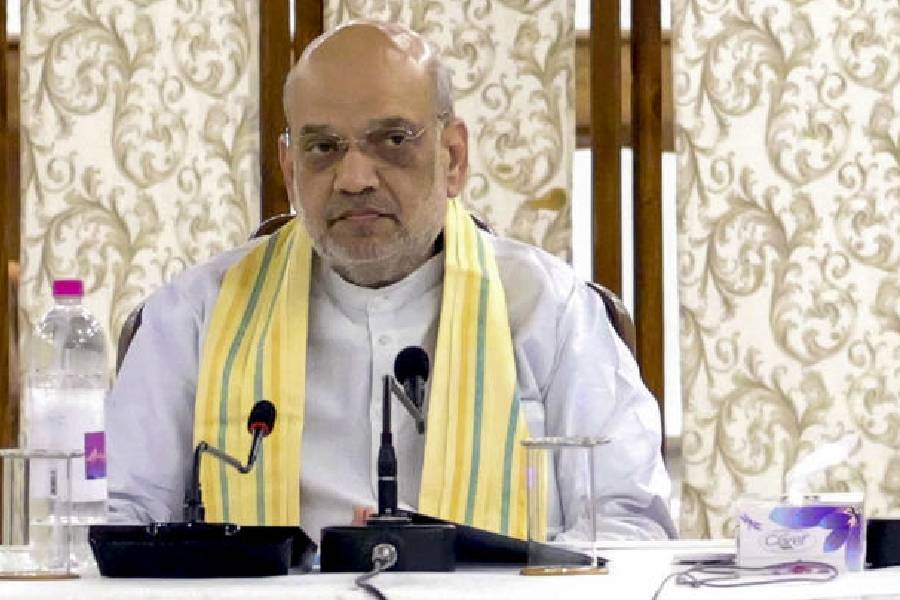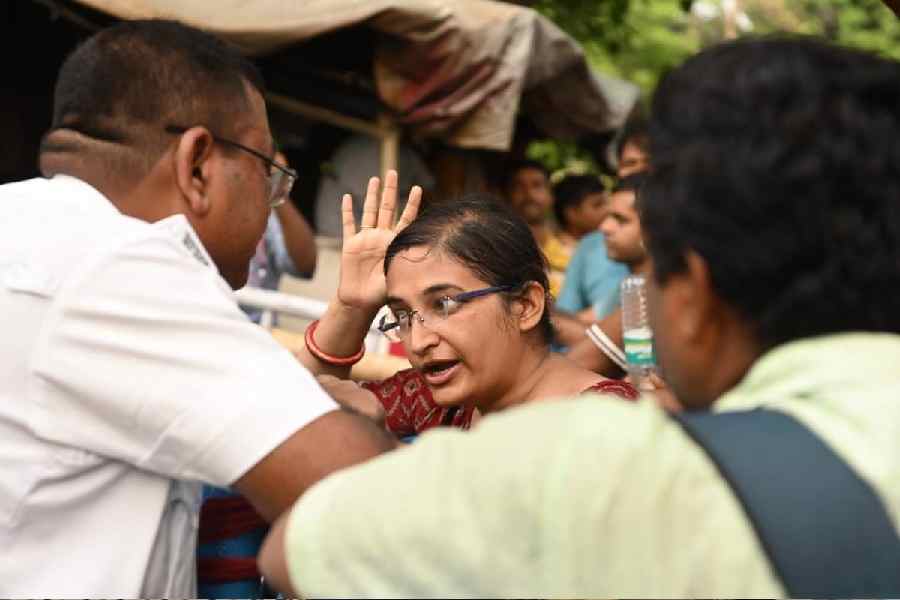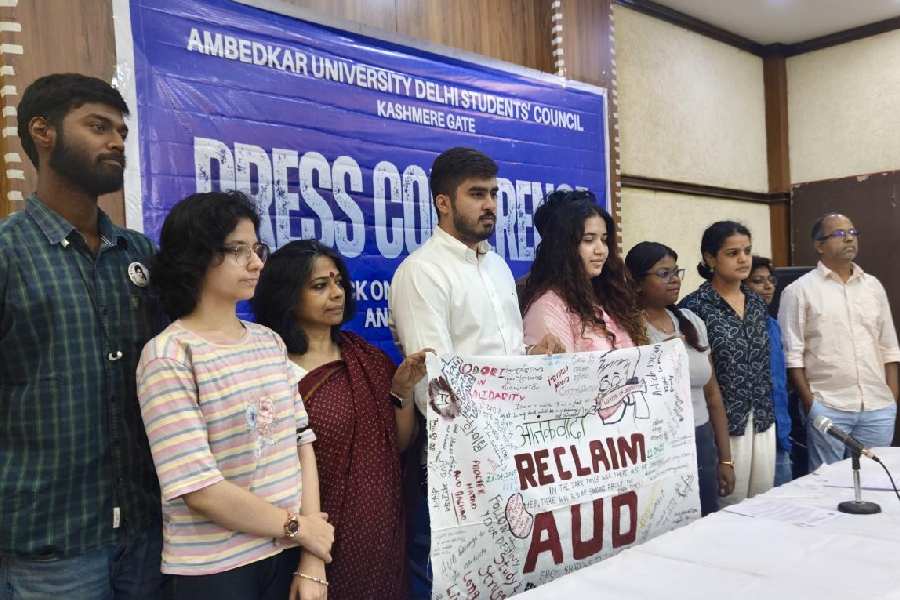|
|
If you drop a coin and don’t pick it up immediately, someone else will. That’s nature’s law. Calcutta — or West Bengal for that matter — must be one of the few places on earth where, if you neglect a piece of land, it’s snatched away by someone else. In the past, it was an avaricious neighbour in collusion with the land records authorities. Now, it is an avaricious promoter in collusion with the land records authorities.
The latest instance of land-grab to provoke that comment refers to the inappropriately named Charlie Chaplin Park (picture) in the even more inappropriately named Cornfield Road in Ballygunge. Once upon a time paddy fields extended beyond the Hookumchand factory and jackals wailed through the night. But now no blade of grass relieves the drabness of Cornfield Road’s crumbling stucco. With parallel Mandeville Gardens choked by South Point School’s monstrous buses and unending stream of cars, the winding length of Cornfield Road, linking Ekdalia Road and Swinhoe Street, is a busy diversion.
All the more reason for a breathing space in this congestion. Some pleasant outlet to which children can escape from the squalor of bustees and stuffiness of poky flats. Charlie Chaplin Park can provide this. But the municipal authorities have allowed it to degenerate into a garbage dump. That is their familiar strategy. Pick out a public space on which some rich promoter has cast his covetous eye, let it become an overgrown jungle, the forlorn haunt of junkies, pimps and prostitutes, and then proclaim that the only way of rescuing it from anti-social abuse is through some lucrative commercial conversion.
We will never know how much money slips into party coffers or the pockets of silken kurtas in these promoter-politician collaborations. It happened in Rawdon Street where a multi-storey car park is wedged along the pavement. A similar fate hangs over Charlie Chaplin Park, though nothing could be more wrong, morally and legally. Riten Bose, now elderly and ailing but whom I remember as a vigorous youthful footballer in the old Ekdalia Evergreen Club and Navajug Sangha, Congress councillor for Ward 68 from 1985 to 1990, tells me that the land used to belong to the shadowy Jamir Mistry, who inspired Jamir Lane near Ballygunge Station. As councillor, he fobbed off several pretenders who tried to say they were Jamir Mistry’s nephews or sons-in-law.
The Calcutta Municipal Corporation acquired the plot under the Urban Land Ceiling Act, and it was registered as a children’s park and playground under the West Bengal Societies Registration Act. Prasanta Sur, the city’s mayor at the time, reiterated that promise of an alternative playground when the Kasba flyover played havoc with roads and buildings and the small triangular Ekdalia Park, where trams used to turn before reaching Ballygunge Station, disappeared.
But greedy souls have been trying to get their hands on the plot ever since. Stellar personalities — Amala Shankar, Soumitra Chatterjee, Swarup Datta, P.C. Sorcar Jr and others — were mobilized in 1994 to thwart a politically well-connected school in Ballygunge Place seeking to expand. That succeeded, but surreptitious filling in of a pond suggests that the mighty Bharat Sevashram Sangha (“Help the distressed, nurse the sick, feed the hungry and clothe the naked”) also wants space. It adjoins Charlie Chaplin Park from behind. The most serious threat is a proposed Rs 100-crore multistorey “development”, a grossly misused word which in Bengali or Hindi signifies desecration and destruction. The development here would be another eyesore of a badly built block of residential flats — what else? — that exploits the dreams (and savings) of middle-class Bengalis to enrich unscrupulous promoters by depriving children and the area of the lungs they need.
This is one of the last remaining open spaces in a Ballygunge whose landscape has changed drastically for the worse. Buildings have swallowed up the emptiness of Singhi Park. Private houses occupy a vacant plot in Mandeville Gardens where Riten Bose and his mates used to kick a football every afternoon. The field between Ekdalia Road and Gariahat Road is a rabbit warren of winding lanes named after Surendranath Tagore. Triangular Park, a little further away in Rashbehari Avenue, has been chopped into three segments: one is a permanent godown for rusty corporation machinery, swings and slides occupy one, and the third is eternally host to social or religious functions. The pretty little gazebo is a ruin.
There can be no debate on Charlie Chaplin Park’s future. It must be restored to be the area’s playground as intended. This is an opportunity also to review municipal policy on public space and facilities. Parks have to be integrated with a city’s life. In Calcutta, a park is “safe” from promoters and predators only if it is kept under lock and key with fearsome durwans guarding the gates. Some parks and squares have been “saved” in this way by being handed over to private companies that nurse luxuriant gardens, as does the military in its allotted share of the Maidan. They are attractive islands of green amidst the city’s grey and brown. But they are like animals in a zoo, to be admired from outside, not experienced within as is a park’s primary purpose.
That is not how one remembers the south-of-Park Street squares with their water-lilies and flowering bushes, and ayahs wheeling prams along asphalt paths or mothers resting on slatted wooden benches painted green. My father always bought seedlings from the vanished Auckland Square malis. The nursery was probably illegal. But the malis had green fingers and the violation was pardonable.
Hazra Park and Park Circus Maidan, scenes of historic rallies, have been chopped up and degraded beyond recognition. Curzon Park barely exists. Various institutions have been allowed to gobble up much of the Dhakuria Lakes. The lately enclosed Padmapukur there is pleasant enough but open only at certain times of the day. The rest of the lakes to which the public has access is a disgrace. The small triangular park at Ballygunge Phanri is locked most of the time. We live in a city that is out of bounds. Thanks to an indulgent friend in uniform, I did manage entrée to what used to be called Ballygunge Maidan but found it too heavily built up for pleasant walking. There is no alternative to streets piled with garbage, pavements that have been reduced to shattered ribbons as roads are widened, and zebra crossings that link railings on both sides of the road.
I strolled down Cornfield Road to see for myself how Charlie Chaplin Park has changed since eleven-a-side matches were played there and found grim desolation. No lighting, uneven ground, mounds of rubbish, and a few cracked and filthy cement benches. In one corner lurched what looked like an abandoned car except that no car, however ramshackle, is abandoned in Calcutta. A battered board proclaimed “Charlie Chaplin Park” and “Shree Shree Sitaram Jew”. Why two “Shrees”? Can the name be real? Is there such a person? Asking around, I was told to talk to someone called Satrajit Ganguly in Muchipara. He pulls the strings.
I hope someone will do so before the builders move in. Understandably, the local heavyweights, Subrata Mukherjee and Rajib Deb, the present councillor, are silent. Politicians are where gains are highest. But not Buddhadeb Bhattacharjee presumably. The Charlie Chaplin Society for Development of Children’s Park and Playground should appeal to his sense of justice and concern for civic rights. It should enlist the support of eminent citizens and involve the courts. Simultaneously, it should collect money, move into the plot and start the work of restoring the park and playground. There’s nothing like direct action in a land where, as I once heard a Calcutta high court judge proclaim approvingly from the bench, possession is nine-tenths of the law. If the society doesn’t do this quickly, the promoters will.











